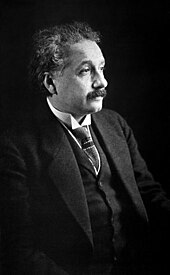Adiabatic principle and action-angle variables
Adiabatic principle and action-angle variables
Throughout the 1910s, quantum mechanics expanded in scope to cover many different systems. After Ernest Rutherford discovered the nucleus and proposed that electrons orbit like planets, Niels Bohr was able to show that the same quantum mechanical postulates introduced by Planck and developed by Einstein would explain the discrete motion of electrons in atoms, and the periodic table of the elements.
Einstein contributed to these developments by linking them with the 1898 arguments Wilhelm Wien had made. Wien had shown that the hypothesis of adiabatic invariance of a thermal equilibrium state allows all the blackbody curves at different temperature to be derived from one another by a simple shifting process. Einstein noted in 1911 that the same adiabatic principle shows that the quantity which is quantized in any mechanical motion must be an adiabatic invariant. Arnold Sommerfeld identified this adiabatic invariant as the action variable of classical mechanics.
Wave–particle duality
Although the patent office promoted Einstein to Technical Examiner Second Class in 1906, he had not given up on academia. In 1908, he became a Privatdozent at the University of Bern.[103] In "über die Entwicklung unserer Anschauungen über das Wesen und die Konstitution der Strahlung" ("The Development of our Views on the Composition and Essence of Radiation"), on the quantization of light, and in an earlier 1909 paper, Einstein showed that Max Planck's energy quanta must have well-defined momenta and act in some respects as independent, point-like particles. This paper introduced the photon concept (although the name photon was introduced later by Gilbert N. Lewis in 1926) and inspired the notion of wave–particle duality in quantum mechanics. Einstein saw this wave-particle duality in radiation as concrete evidence for his conviction that physics needed a new, unified foundation.
Theory of critical opalescence
Einstein returned to the problem of thermodynamic fluctuations, giving a treatment of the density variations in a fluid at its critical point. Ordinarily the density fluctuations are controlled by the second derivative of the free energy with respect to the density. At the critical point, this derivative is zero, leading to large fluctuations. The effect of density fluctuations is that light of all wavelengths is scattered, making the fluid look milky white. Einstein relates this to Rayleigh scattering, which is what happens when the fluctuation size is much smaller than the wavelength, and which explains why the sky is blue.[104] Einstein quantitatively derived critical opalescence from a treatment of density fluctuations, and demonstrated how both the effect and Rayleigh scattering originate from the atomistic constitution of matter.
Zero-point energy
Einstein's physical intuition led him to note that Planck's oscillator energies had an incorrect zero point. He modified Planck's hypothesis by stating that the lowest energy state of an oscillator is equal to 1⁄2hf, to half the energy spacing between levels. This argument, which was made in 1913 in collaboration with Otto Stern, was based on the thermodynamics of a diatomic molecule which can split apart into two free atoms.

